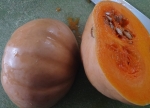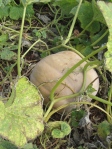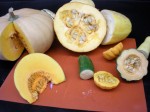Jeanne introduces the diversity of some American natives, the squashes in the genus Cucurbita.
Spring is officially here, and I have squash on my mind. We’ve ordered zucchini seeds for the upcoming summer garden but still have acorn squash from the fall sitting in the pantry (both are varieties of Cucurbita pepo). Our winter vegetable CSA box recently bequeathed to us the tastiest winter squash I’ve ever eaten, a Seminole pumpkin, which is a different variety of the same species (Cucurbita moschata) as the butternut squash sitting on the counter, destined for dinner. Now between last year’s hard winter squashes and the tender summer squashes to come seems a good time to remind ourselves of the origins and diversity of squashes in the genus Cucurbita.
Four hundred years ago, stored C. moschata would certainly have been a springtime diet staple of the Native American tribes in what is now the southeastern United States, including the Seminole. The squash that bears their name grows as a sprawling plant with the huge palmate leaves and curling tendrils typical of cucurbits, members of the gourd family (Cucurbitaceae), which also includes cucumbers, melons and inedible gourds and natural loofah sponge. Like many other cucurbits, Seminole squash plants will spread over the ground, and more than most other cucurbits, it can grow as a vine (some Cucurbita varieties resemble a bush more than a vine and do not climb). Accounts of early Spanish explorers to Florida record their surprise at seeing Seminole squash fruits hanging from trees over rivers or decorating dead oaks that the Native Americans used as trellises to farm the squashes. Native Americans traditionally sliced and sun-dried strips of the squash for transport and storage. The large, nutritious seeds, however, were as important a food source as the sweet flesh.
Seminole pumpkin vines have a reputation as particularly resistant to the abundant pests in its swampy native environment, and the hard outer shell on this grapefruit-sized squash helps keep the fruit impervious, for up to months. Pathogens and insects still affect it, but if left to its own devices in a swamp, it would fare better than the average butternut from the seed catalog. In the absence of a hard winter freeze, roots can develop from nodes in contact with soil, continuously producing new plants and fruit. Some authors attribute the climbing tendencies, ability to self-perpetuate through adventitious roots and self-seeding, and pest-hardiness of the Seminole variety of C. moschata to occasional hybridization with other wild squashes native to the Florida swamps, such as C. okeechobeensis (Morton 1975).
Hardiness of the plants is usurprising given the means by which the cucurbit lineages arrived in the Neotropics. The family Cucurbitaceae arose near modern-day India in the late Cretaceous. The leading hypothesis for how cucurbits migrated from the Asian subcontinent to every other continent except Antarctica is transoceanic long-distance dispersal. That is, the hardy squashes floated across the ocean, or the seeds were carried in the guts of birds that flew them from A to B. Ancestral cucurbits made the journey from Africa to South America approximately five times, where their descendants radiated into around 350 modern species. The genus Cucurbita split from its sister clade (Peponposis) between 9 and 23 million years ago in Central or South America. Between then and the onset of American agriculture ancestral Cucurbita expanded from Central to North America around seven times (Schaefer et al. 2009).
Those northern radiations of the genus resulted in three highly variable species that constitute the vast majority of pumpkins and other squash consumed in the world: Cucurbita pepo, C. moschata, and C. maxima. Two additional Cucurbita species, C. argyrosperma (cushaw) and C. ficifolia (fig-leaf gourd), are cultivated in a few areas. C. pepo includes most varieties of the round, orange squashes called “pumpkins” sold for Halloween Jack-O-Lanterns, although all Cucurbita species have some varieties with names including “pumpkin,” such as the amazing variety of C. maxima called “Amish pie pumpkin” and the “Long Island Cheese Pumpkin” variety of C. moschata. C. pepo also includes zucchini, yellow summer squash, pattypan, delicata, spaghetti squash, and acorn squash. C. maxima includes the Hubbard, turban, and kabocha squashes. C. moschata are the butternuts.
All Cucurbita species are native to the Americas, a dozen or so species with scattered wild distributions, mostly in Mexico. Domestication of at least five Cucurbita species predated European exploration of the Americas by several thousand years. C. pepo may have been domesticated in the Americas ten thousand years ago, around the same time that wheat was domesticated in the Mediterranean.
Remains of C. moschata have been identified from abandoned Native American settlements from the southwestern United States (from 1500-2000 year BCE) and Guatemala (from around 900 AD). The species likely arose in Central America and from there spread south, where its seeds have been found in centuries-old Peruvian tombs, and north, with corn and beans. European explorers introduced American Cucurbita to the rest of the world starting in the early 16th century. Climatic preference differences among Cucurbita species influences their modern distribution around the globe’s agricultural regions. C. moschata prefers hotter, more humid conditions than its congeners.
Like cultivars of Brassica oleracea, distinct named cultivars of these Cucurbita squash species have been developed through selective breeding over centuries, and most are totally interfertile within a species, and the species do occasionally hybridize. Some cultivars, especially the zucchini, yellow summer squash and vegetable marrow cultivars of C. pepo, have been developed for their immature fruit, meant to be picked when the skin is still soft, inner flesh still firm, and seeds small and tender, before maturation of the hard outer shell and hollow interior full of stringy endocarp.

Compost pile volunteer C. pepo (presumably) vine, probably produced by the hybridization of two commercial varieties grown by the farmer from whom we purchased a squash the previous summer.
Most of the dizzying number of squash varieties, however, have been developed under selection for various characteristics of the mature fruit, including texture, flavor and quantity of the firm flesh; shell color; fruit shape; and long-term storage stability. At least one variety in Mexico was developed primarily for the mature seeds—pepitas—a staple of Oaxacan cuisine (if you’ve never put toasted hulled pumpkin seeds on your salad, do it, especially if you’ve soaked the raw seeds in a bit of chipotle-maple marinade before toasting them).
Much is known of the genetic basis of the tremendous variation among Cucurbita species in fruit shape (long like a zucchini, crookneck-shaped, butternut-shaped, spherical-ish, disk-shaped, deeply ribbed like acorn squash); shell lignification (becoming hard and woody instead of staying mostly soft, like in zucchini); color (white, green, mottled, striped, orange, yellow, bluish); size (think mini pumpkin vs prize-winning 1800-pound monsters); beta carotene content (carotenes—Vitamin A—make the fruit of most winter squashes yellow to orange); and many other complex traits (Paris and Brown 2005).
A gene unique to C. pepo that I think is especially interesting is called “sp.” When a hapless C. pepo inherits two copies of the recessive allele (gene variant) of the sp gene from its parents, the fruit flesh will have “spaghetti” texture, breaking into long strands when cooked (Paris and Brown 2005). Hence, the name for “spaghetti squash” or “vegetable spaghetti.” As cultivars of C. pepo, pumpkins, acorn squash, and over-ripe zucchini can also be stringy. If you cook up your Jack-O-Lantern pumpkins after Halloween, you might have to put the flesh through the blender to puree the strings. The anatomical basis of spaghetti texture is not well known. My literature search on the topic only turned up one conference paper (Ishii et al. 2011) that demonstrated that the strands disassociate because of the breakdown during cooking of pectins that help glue cells together.
The strands, however, are hundreds of cells thick, so the mechanism causing particularly soluble pectins at regular intervals, and how it could be related to the product of gene sp, is unknown. We also know that the fruit becomes more stringy as the fruit ages and matures, so strand formation is probably also related to fruit maturation. What I do know is that I am one of many squash enthusiasts who strongly prefers the flavor and firm texture of C. maxima or C. moschata over that of C. pepo. It’s no mystery why most canned pumpkin is C. moschata. It makes better pies. I think any recipe that calls for pumpkin, be it soup, pie, or Moroccan tagine, would be best prepared using either a C. maxima or a C. moschata instead of a C. pepo, although delicata squash seems to be the most flavorful and least stringy of the C. pepo group, but it would take a lot of delicata to produce as much pulp as an average butternut.
If you grow squash plants for the fruit, go easy on the flowers. The edible Cucurbita species have separate male and female flowers, both of which are large, the size of tiger lilies. Most gardeners do not need all of their male flowers to ensure pollination of the female flowers (by bees and necessary for fruit set). Extra male flowers can be picked as soon as they’re open, stuffed, battered, and fried as delicious fritters. If you’re particularly enthusiastic about eating squash blossoms, you can make proportionately more male flowers by damaging leaves prior to flower development. In plants that produce unisexual flowers, like squash, leaf herbivory has been shown to bias the sex ratio of flowers on a particular plant to favor male flowers, which require fewer resources to produce than female flowers (Krupnick et al. 2000). Of course, you might just end up with fewer flowers overall because leaf damage depletes the plant’s energy and nutrient reserves. C. ficifolia is sometimes cultivated for salad greens as well as fruit and seeds, but if maximizing fruitset is your goal, I’d leave the leaves alone. I suppose the big leaves of other Cucurbita species are edible, but they might be bitter, due to the high concentrations of exceedingly bitter cucurbitacin defense compounds. If you are familiar with bitter melon (Momordica charantia), a south Asian cucurbit, then you are familiar with cucurbitacins. Sometimes you can taste cucurbitacin bitterness in the rind of cucumber or slightly immature hard winter squashes.
Tonight’s butternut, though, looks plenty ripe. It will get cubed, tossed in melted butter and olive oil with some salt and roasted. Ever since we ate the Seminole squash, roasting C. moschata makes me think of vines dripping over steamy Florida swamps. Maybe you too will now see American history in your squash. Or maybe I just need a tropical vacation.
References
Fritz, G.J. 1994. Precolumbian Cucurbita argyrosperma spp. argyrosperma (Cucurbitaceae) in the Eastern Woodlands of North America. Economic Botany 48: 280-292.
Ishii, K., A. Teramoto, H. Kuwada, Y. Jibu, M. Tabuchi, Y. Kimura, and M. Fuchigami. 2011. Relationship between pectic substances and strand separation of cooked spaghetti squash. http://www.icef11.org/content/papers/aft/AFT594.pdf
Morton, J.F. 1975. The sturdy Seminole pumpkin provides much food with little effort. Proc. Florida State Hort. Soc. 88:137-142.
Paris, HS, N Yonash, V Portnoy, N Mozees-Daube, G Tzuri and N Katzir. 2003. Assessment of genetic relationships in Cucurbita pepo (Cucurbitaceae) using DNA markers. Theoretical and Applied Genetics 106: 971-978.
Paris, H. S., and R. N. Brown. 2005. The genes of pumpkin and squash. HortScience 40: 1620-1630.
Schaefer, H., C. Heibl, and S. S. Renner. 2009. Gourds afloat: a dated phylogeny reveals an Asian origin of the gourd family (Cucurbitaceae) and numerous oversea dispersal events. Proceedings of the Royal Society B 276: 843-851.










Pingback: Nibbles: Cucurbits, Climate change cuisine, Passover pulses, Quinoa grant
Another wonderfully informative article.
I can attest to the edibility of C. moschata leaves and young shoots grown in Papua New Guinea, which are extra tasty because they hold on to the coconut cream they are cooked in. ‘Pumpkin’ leaves (sorry, don’t remember the local name) are also eaten in Tanzania, cooked in a little cooking oil or margarine. You just need to remove the tendrils. I think one of the benefits of eating the leaves is to stop the plants crazily taking over your farm!
LikeLike
Thanks so much, Anne-Marie, for the kind note and interesting information about cooking C. moschata leaves! I wonder what varieties are grown there in PNG.
LikeLike
Mature C. ficifolia flesh is really quite stringy, but more watery than spaghetti squash cultivars and is used to make “angel’s hair” jam or “shark’s fin melon” soup, due to its similar consistency to shark flesh. Even in the cool British climate it will climb up into trees and hedges and gives a lovely tropical feel to the garden.
LikeLike
Yet another fascinating post. Keep ’em coming.
The Seminole pumpkin has a remarkable, painful, and beautiful ethnobotanical history. I wrote about it here: http://athinkingstomach.blogspot.com/2010/12/survivor.html
The best-tasting, best-textured squash I’ve ever tasted is Uncle David’s Dakota Dessert. Oooooh baby, that is a good winter squash.
LikeLike
That’s a beautiful essay on Seminole squash, Christina. Thanks so much for sharing and for the squash tip!
LikeLike
Pingback: Greens: why we eat the leaves that we do | The Botanist in the Kitchen
Pingback: Making ratatouille like a botanist | The Botanist in the Kitchen
Pingback: Going bananas | The Botanist in the Kitchen
love this blog. I discovered it a couple of days ago, and now I’m in the process of reading through the whole thing.
Just one little thing–the pic you identify as a bitter melon looks like no Momordica I have encountered. Looks to me like a Cucumis.
LikeLike
You’re right–it was this.
LikeLike
Pingback: Other interests | Regional Awareness
Pingback: How giant pumpkins got so big: A Q&A with Jessica Savage | The Botanist in the Kitchen
Pingback: Throwback Thursday Thanksgiving feast | The Botanist in the Kitchen
Pingback: Botany Lab of the Month: Jack-O-Lantern | The Botanist in the Kitchen
Pingback: [Instant Pot] Insta-Pumpkin! DIY Pressure Cooker Pumpkin Puree | flavorrd
Pingback: The Botanist in the Root Cellar | The Botanist in the Kitchen
Pingback: [Instant Pot] Insta-Pumpkin! DIY Pressure Cooker Pumpkin Puree - Fueled By Instant Pot